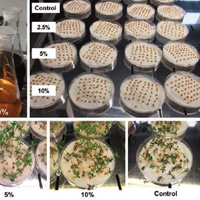Effect of Fucus extract and biomass enriched with Cu(II) and Zn(II) ions on the growth of garden cress (Lepidium sativum) under laboratory conditions

Accepted: 15 February 2021
PDF: 473
All claims expressed in this article are solely those of the authors and do not necessarily represent those of their affiliated organizations, or those of the publisher, the editors and the reviewers. Any product that may be evaluated in this article or claim that may be made by its manufacturer is not guaranteed or endorsed by the publisher.
In the present study, brown seaweed - Fucus vesiculosus was used as a raw material for the preparation of bio-products for sustainable agriculture. Biosorption was applied to produce fertilizer additives with microelements. F. vesiculosus was enriched with Cu(II) and Zn(II) ions. Biostimulants of plant growth were obtained by seaweed extraction with potassium hydroxide. Different doses of enriched F. vesiculosus (1, 2, 4, 6 mg/per Petri dish) and concentrations of seaweed extract (2.5, 5 and 10%) were examined in germination test on garden cress (Lepidium sativum). The effect of both algal products on the plant length, RGB parameters in leaves and biomass multielement composition was examined. Results showed that the biomass enrichment did not influence plant length and RGB parameters. Taking into account these two parameters, the best results were obtained in the group treated with natural F. vesiculosus (higher than in the control group, treated with distilled water). Enriched F. vesiculosus biofortified garden cress with Cu and Zn. In the case of Fucus extract, 5% concentration increased plant length and the value of RGB parameters when compared with the control group. Also this extract concentration resulted in elevated content of micro- and macroelements in Lepidium sativum. Seaweed extract is recommended for further research as biostimulant of plant growth.
Highlights
- Fucus vesiculosus is a valuable raw material for agriculture.
- Fucus vesiculosus extract can act as biostimulants of plant growth.
- Fucus vesiculosus enriched with microelements via biosorption can be used as a fertilizing material providing plants with these nutrients.
- Fucus products can biofortify edible plants in essential microelements.
- Fucus extracts can enhance plant length and chlorophyll content.
How to Cite

This work is licensed under a Creative Commons Attribution-NonCommercial 4.0 International License.
PAGEPress has chosen to apply the Creative Commons Attribution NonCommercial 4.0 International License (CC BY-NC 4.0) to all manuscripts to be published.

 https://doi.org/10.4081/ija.2021.1799
https://doi.org/10.4081/ija.2021.1799







